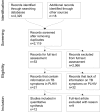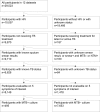Development of a standardized screening rule for tuberculosis in people living with HIV in resource-constrained settings: individual participant data meta-analysis of observational studies
- PMID: 21267059
- PMCID: PMC3022524
- DOI: 10.1371/journal.pmed.1000391
Development of a standardized screening rule for tuberculosis in people living with HIV in resource-constrained settings: individual participant data meta-analysis of observational studies
Abstract
Background: The World Health Organization recommends the screening of all people living with HIV for tuberculosis (TB) disease, followed by TB treatment, or isoniazid preventive therapy (IPT) when TB is excluded. However, the difficulty of reliably excluding TB disease has severely limited TB screening and IPT uptake in resource-limited settings. We conducted an individual participant data meta-analysis of primary studies, aiming to identify a sensitive TB screening rule.
Methods and findings: We identified 12 studies that had systematically collected sputum specimens regardless of signs or symptoms, at least one mycobacterial culture, clinical symptoms, and HIV and TB disease status. Bivariate random-effects meta-analysis and the hierarchical summary relative operating characteristic curves were used to evaluate the screening performance of all combinations of variables of interest. TB disease was diagnosed in 557 (5.8%) of 9,626 people living with HIV. The primary analysis included 8,148 people living with HIV who could be evaluated on five symptoms from nine of the 12 studies. The median age was 34 years. The best performing rule was the presence of any one of: current cough (any duration), fever, night sweats, or weight loss. The overall sensitivity of this rule was 78.9% (95% confidence interval [CI] 58.3%-90.9%) and specificity was 49.6% (95% CI 29.2%-70.1%). Its sensitivity increased to 90.1% (95% CI 76.3%-96.2%) among participants selected from clinical settings and to 88.0% (95% CI 76.1%-94.4%) among those who were not previously screened for TB. Negative predictive value was 97.7% (95% CI 97.4%-98.0%) and 90.0% (95% CI 88.6%-91.3%) at 5% and 20% prevalence of TB among people living with HIV, respectively. Abnormal chest radiographic findings increased the sensitivity of the rule by 11.7% (90.6% versus 78.9%) with a reduction of specificity by 10.7% (49.6% versus 38.9%).
Conclusions: Absence of all of current cough, fever, night sweats, and weight loss can identify a subset of people living with HIV who have a very low probability of having TB disease. A simplified screening rule using any one of these symptoms can be used in resource-constrained settings to identify people living with HIV in need of further diagnostic assessment for TB. Use of this algorithm should result in earlier TB diagnosis and treatment, and should allow for substantial scale-up of IPT.
Conflict of interest statement
HG and RG are staff members of the World Health Organization. The authors alone are responsible for the views expressed in this publication and they do not necessarily represent the decisions or policies of the World Health Organization.
Figures




References
-
- Getahun H, Gunneberg C, Granich R, Nunn P. HIV infection-associated tuberculosis: the epidemiology and the response. Clin Infect Dis. 2010;50:S201–207. - PubMed
-
- Sonnenberg P, Glynn JR, Fielding K, Murray J, Godfrey-Faussett P, et al. How soon after infection with HIV does the risk of tuberculosis start to increase? A retrospective cohort study in South African gold miners. J Infect Dis. 2005;191:150–158. - PubMed
-
- Havlir DV, Getahun H, Sanne I, Nunn P. Opportunities and challenges for HIV care in overlapping HIV and TB epidemics. JAMA. 2008;300:423–430. - PubMed
-
- Mukadi YD, Wiktor SZ, Coulibaly IM, Coulibaly D, Mbengue A, et al. Impact of HIV infection on the development, clinical presentation, and outcome of tuberculosis among children in Abidjan, Cote d'Ivoire. Aids. 1997;11:1151–1158. - PubMed
-
- Manosuthi W, Chottanapand S, Thongyen S, Chaovavanich A, Sungkanuparph S. Survival rate and risk factors of mortality among HIV/tuberculosis-coinfected patients with and without antiretroviral therapy. J Acquir Immune Defic Syndr. 2006;43:42–46. - PubMed
Publication types
MeSH terms
Grants and funding
LinkOut - more resources
Full Text Sources
Medical

